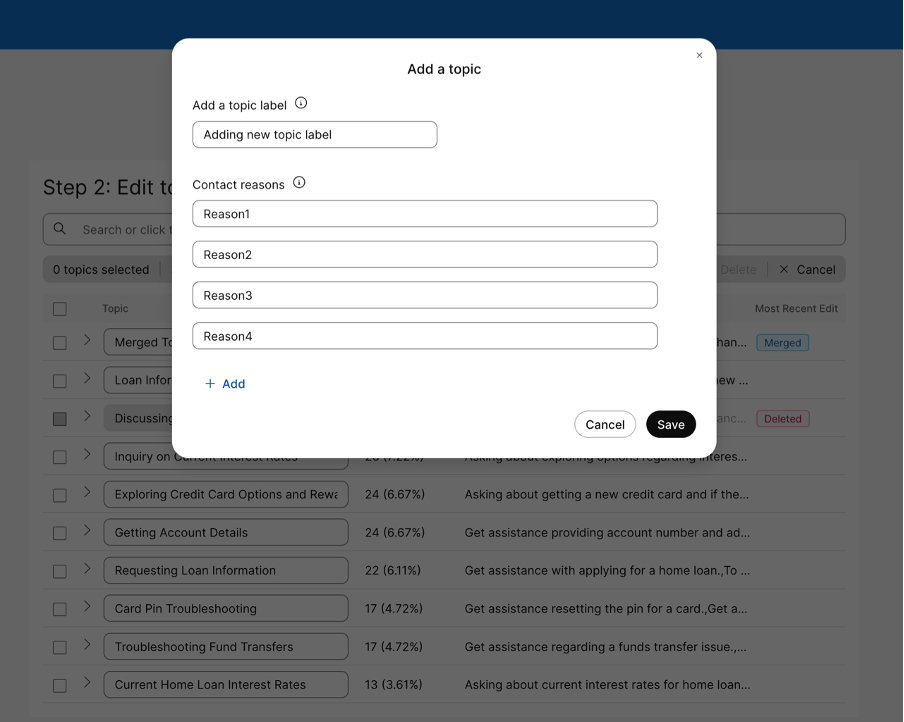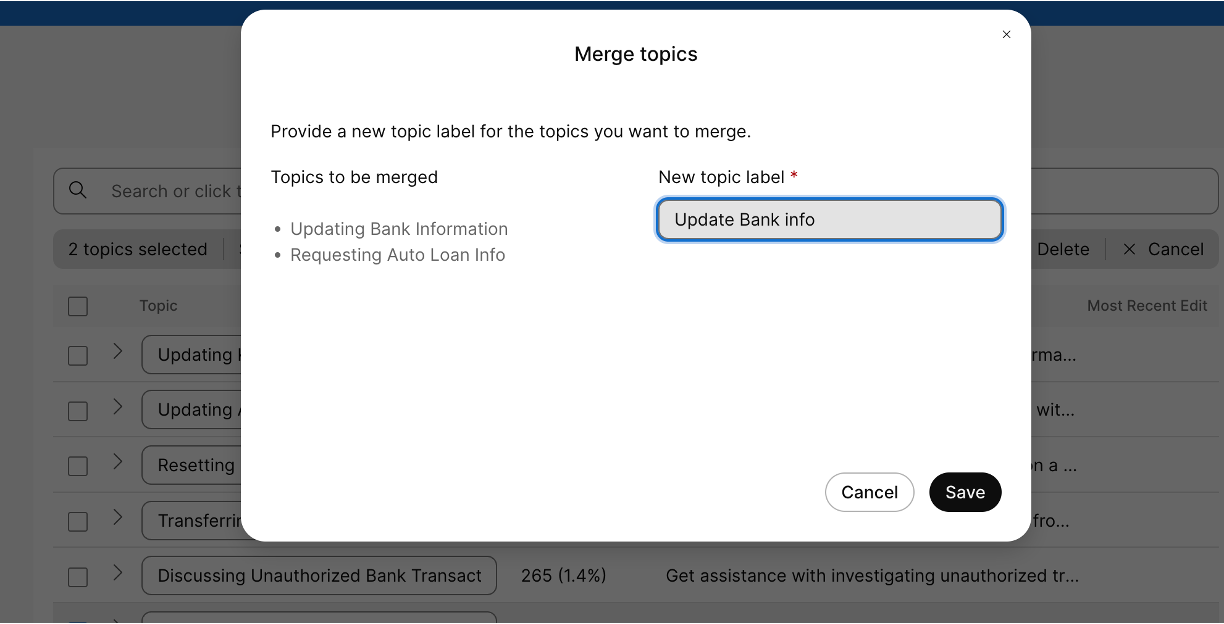- Home
- /
- Article



Get started with Topic Analytics
 In this article
In this article Feedback?
Feedback?Topic Analytics helps you identify the topics in the conversation between an agent and the caller. You can use the created topic collection to monitor trends and assist agent training as new topics are identified.
Overview
Topic Analytics provides faster insights on the top contact reasons of the contact center. You can create a topic collection to identify the reasons for the call and view the insights for the created collection based on the filter criteria.
On the Overview page, you can choose the call records to create a collection and review it for the selected transcriptions. The transcription is a record of the conversation between the agent and the caller.
Topic collection
You can view the list of collections created for the available transcriptions. The Create topic collection lets you create a collection with selected filters. You can analyze the chat or call conversations between an agent and the caller. The system displays the status of each collection analyzed along with the initiated time and date.
Collection definitions
-
Contact reasons—Contact reasons are AI-generated summaries of the reason for the call.
-
Topics—a representative label for groupings of similar contact reasons. That is, topics are AI-generated groupings with a label that best summarizes the type of call reasons found in that grouping.
Provide Feedback
You can provide feedback on the accuracy of a generated collection or its topics and contact reasons.
-
Collection feedback—On the Topic Analytics page, you can provide quick and easy feedback on the overall collection performance. Click the thumbs up or thumbs down icon to provide a general interest of how helpful the collection is.
-
Contact record feedback—In the Topic Analytics section:
-
Click Thumbs up or Thumbs down to provide a general interest regarding the topic.
-
Click the pencil icon to open the Tell us more text box to provide more information about the topic. If a topic is determined to be helpful or unhelpful, you can provide more details as to why.
-
Access Topic Analytics
- Customers must purchase the new AI Assistant add-on SKU (A-FLEX-AI-ASST) for their organization. This add-on includes Topic Analytics and all the AI Assistant features.
- Currently, only users with the roles of Contact Center Service Administrator or Full Administrator have access to Topic Analytics.
- Analysts and supervisors have to access Topic Analytics data in Analyzer through custom reports and the AI Assistant dashboard.
-
Sign in to the Control Hub using the URL https://admin.webex.com.
-
From the Services section of the navigation pane, choose Contact Center.
-
In Quick links in the right pane, click Topic Analytics to open the application.
The system opens the Topic Analytics application in another browser tab and you’re automatically signed-in to the application.
-
From the Overview page, click Topic Analytics to view the Topic Analytics page.
Before you begin
Topic analytics requires a minimum of 2,000 call recordings to successfully perform the analysis.
-
We recommend you to use 7000 unique transcriptions for accuracy. Select transcriptions from the full variety of calls that you receive.
-
You can use only English transcriptions for now.
Create a topic collection
You can create a topic collection based on a set of filter criteria.
-
Click Create topic collection.

-
Select the date range to represent the variety of calls for your organization. The date range determines the start and end date of the report for the collection.
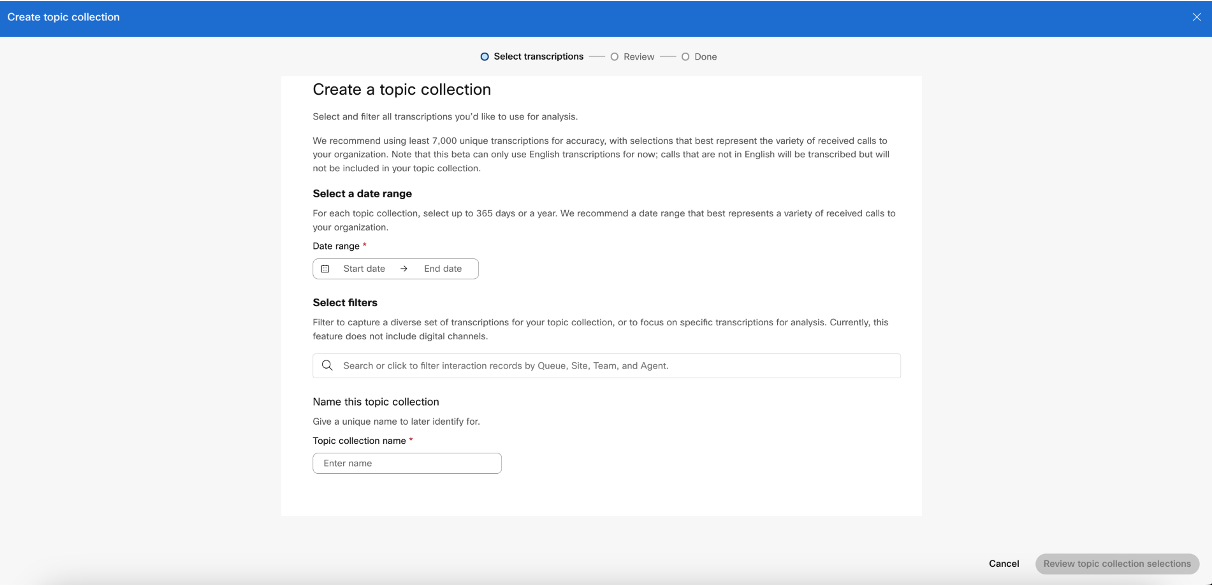
-
Use the filter to select the transcriptions to include with the collection. For example, you can filter by queue, team or agent.
-
Enter the topic collection name.
-
Click Review topic collection selections to review the collection selections.
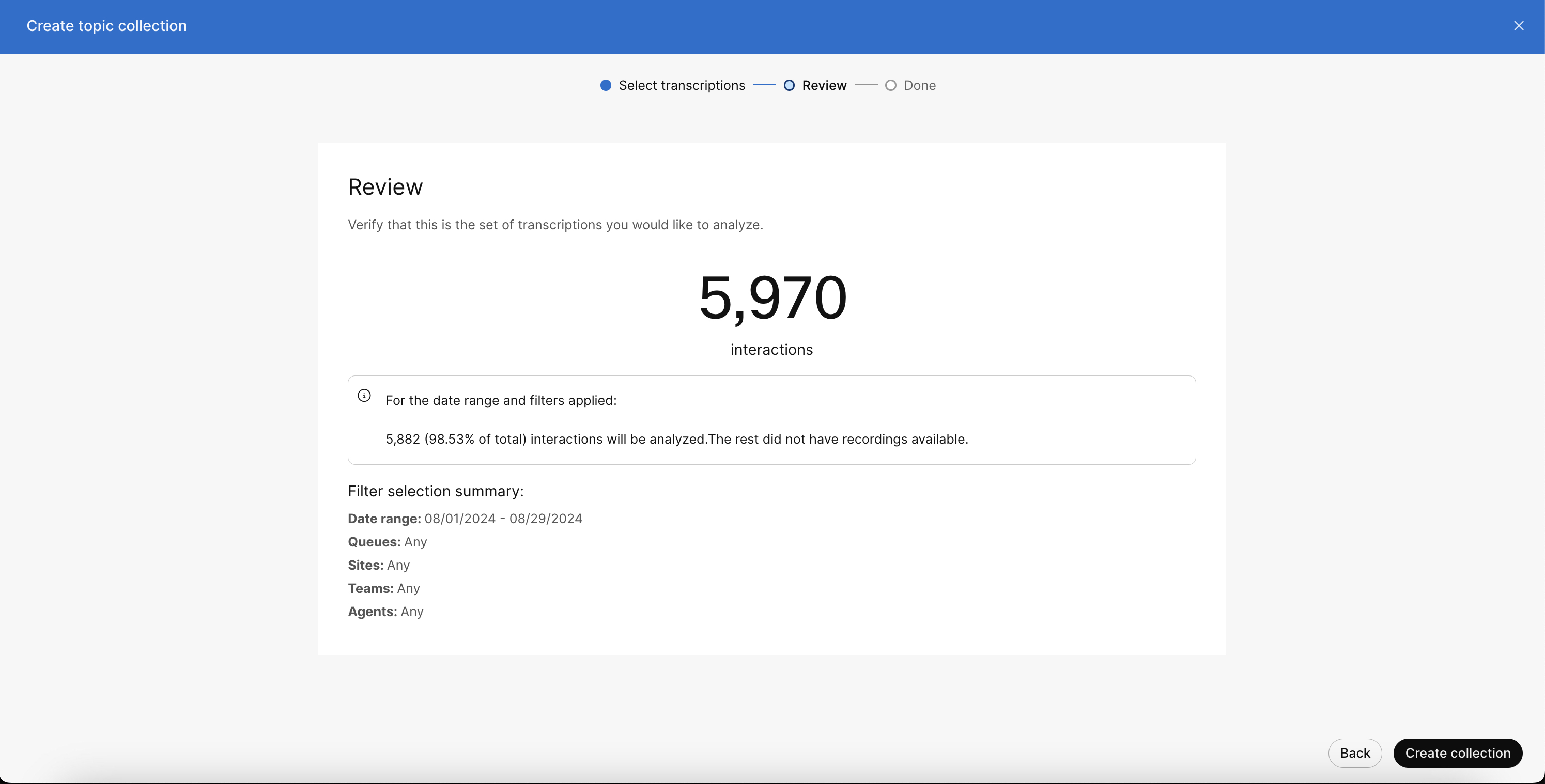
-
Click Create topic collection.
Topic collection can take up to 24 hours to complete.
You can see the following statuses of the topic collection on the Topic Analytics page.
Table 1. Collection creation statuses Status Description Queued The collection request has been submitted and is currently in the queue, awaiting processing.
In progress The collection is currently in the process of being created.
Complete The collection has been successfully created and is now available for use.
Failed The collection couldn’t be created in the system. Contact Cisco support for further assistance.
Delete a topic collection
You can delete a collection that is no longer needed or are less interesting for your analysis.
-
On the Topic Analytics page, click Delete against the collection you want to delete.
View a topic collection
Once you create the topic collections for analysis, you can view the list of topic collections along with the status.
-
Navigate to the Topic Analytics page.
-
Click on a topic collection to view the following tabs:
- Overview—This tab shows the filters such as Date range, Queues, Sites, Teams,
and Agents. You can use these filters to create the topic collection. You can see the
breakdown of interactions analyzed based on these criteria, depending on the
availability of call recordings.
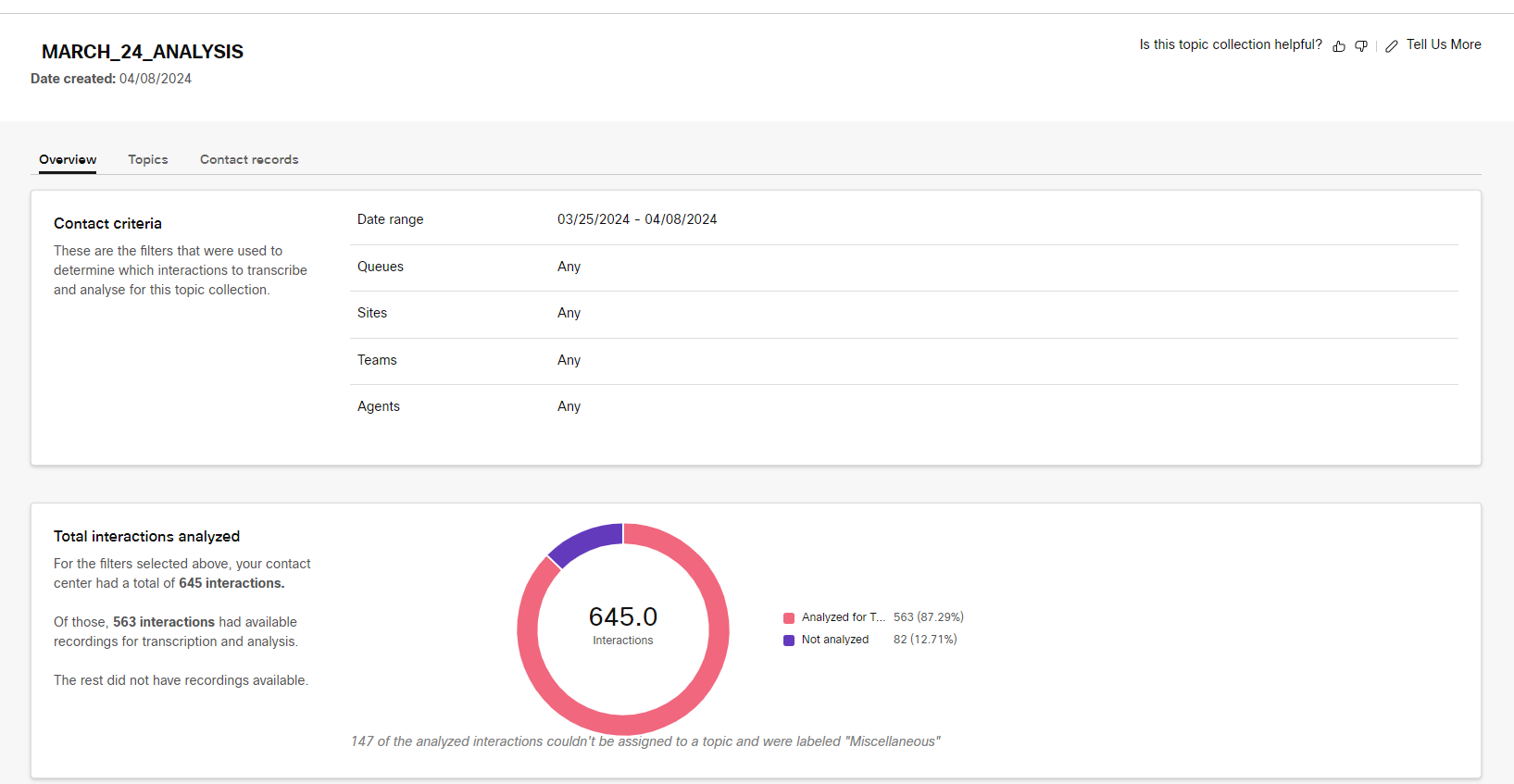
- Topics—click the Topics tab to view the topics table that lists the
following details:
-
Rank—The order of position in the list of identified topics based on a number of transcripts analyzed in the order of high to low.
-
Topic—The label for groupings of similar contact reasons.
-
Transcripts (% of collection)—The number represents the total transcripts that were assigned the given topic label and the % represents the percentage distribution of this topic relative to the total interactions analyzed.
-
Sample contact reasons—The sample contact reasons identified for a given topic.
You can expand or collapse the individual topics to view all the contact reasons and transcript count corresponding to that topic.
Also, you can click the Export icon in the top-right corner of the topics table to download the topics in .xlsx format to your local folder for analysis.
You can click on each topic to view all the contact records corresponding to that topic in the Contact records tab.
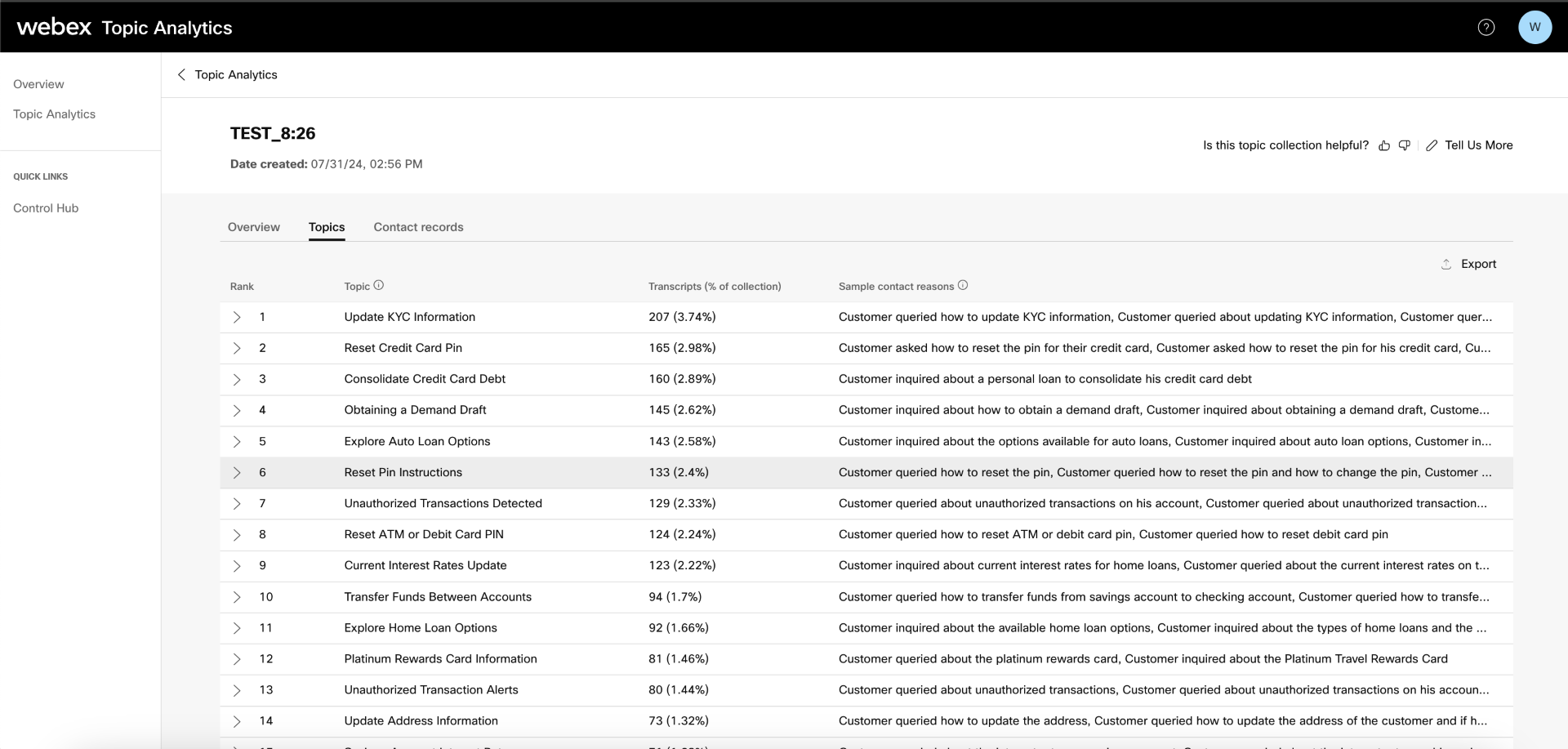
-
- Contact records—Lists all the contact records with the following details:
Interaction ID, Time and date, Topic, and Contact reason. You can use the search bar
to type keywords or choose one or more topics from the drop-down to filter your
contact records.
Also, you can drill down to the following details of a specific contact record from the contact record table. Double-click on a contact to view the following details:
- Recording of the interaction between the caller and agent for the selected contact record.
- Transcription of the recording of the selected contact record.
- Contact details, such as Session ID, Date and time, Duration, Queue, Site, Team, Agent, Origin, and Destination.
- Topic Analytics where you can view the topic and contact reason corresponding to the selected contact record.
-
Provide feedback on the topic and contact reason. For more information, see the Provide Feedback section.
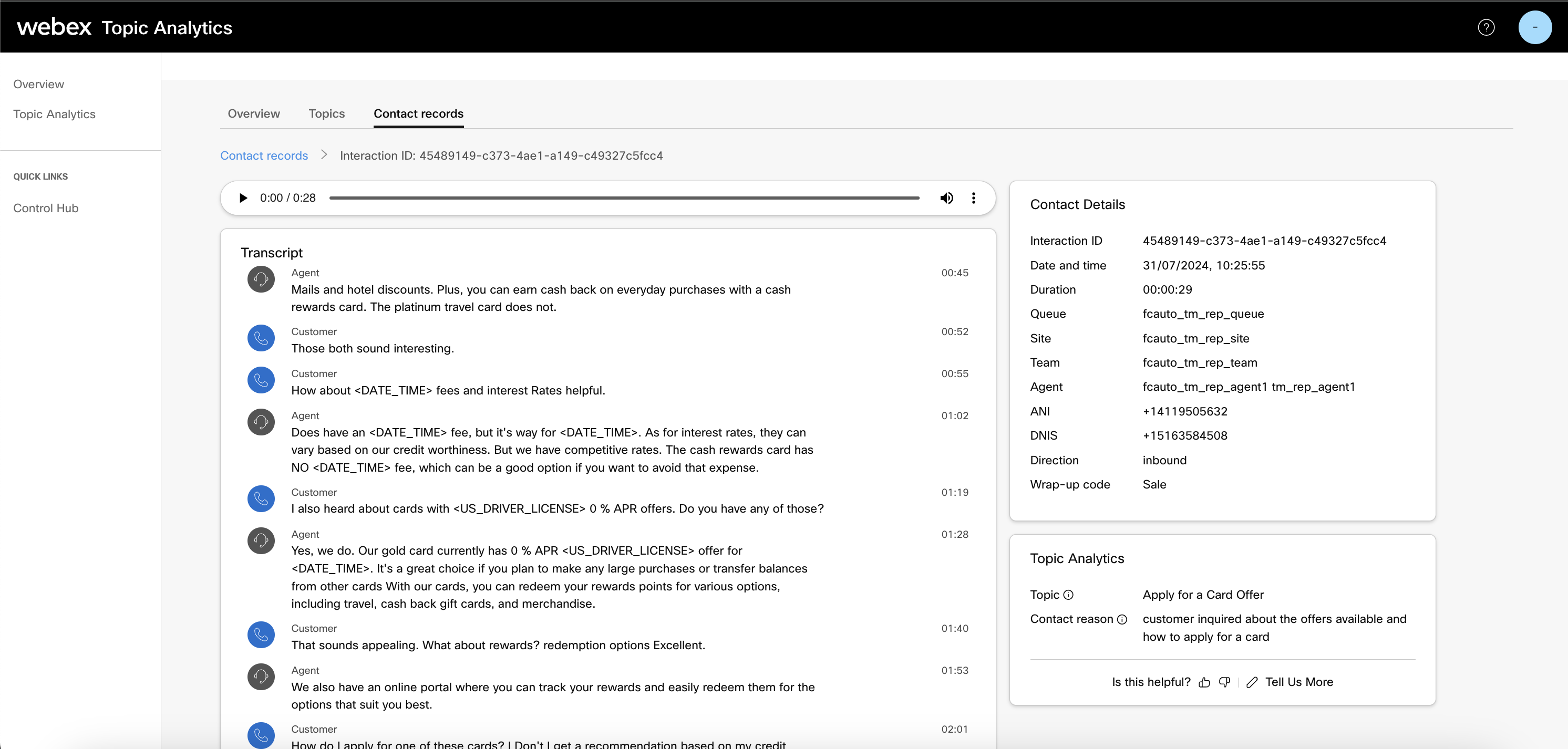
- Overview—This tab shows the filters such as Date range, Queues, Sites, Teams,
and Agents. You can use these filters to create the topic collection. You can see the
breakdown of interactions analyzed based on these criteria, depending on the
availability of call recordings.
Edit topics in topic collection
Topic Analytics enables you to modify your topic collections, allowing you to tailor the topics to better fit specific business needs, language, and terminology. You can perform the following edits:
- Rename topics
- Merge topics
- Delete topics
- Add new topics
To edit your topics, first create a copy of your current collection. This copy retains the same date range and filter settings, and any changes you make to your existing topics apply to the new collection.
| 1 |
Navigate to the Topic Analytics page. |
| 2 |
Click on a topic collection that you wish to edit. |
| 3 |
Click Edit Topics on the top-right corner. |
| 4 |
In the Name Copy screen, edit the topic collection name. By
default, 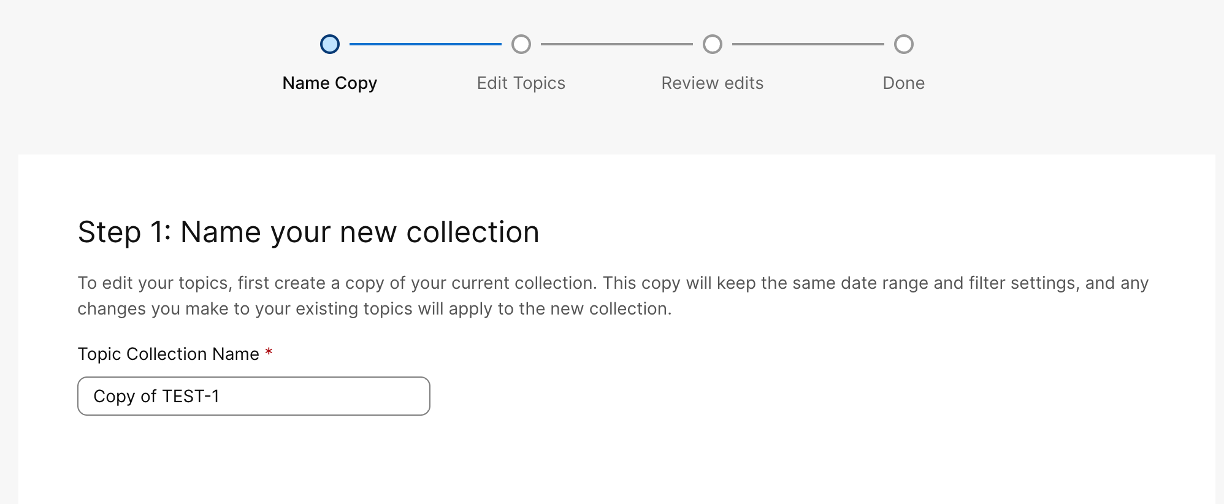
|
| 5 |
Click Next. |
| 6 |
In the Edit topics screen, you can perform the following edits:
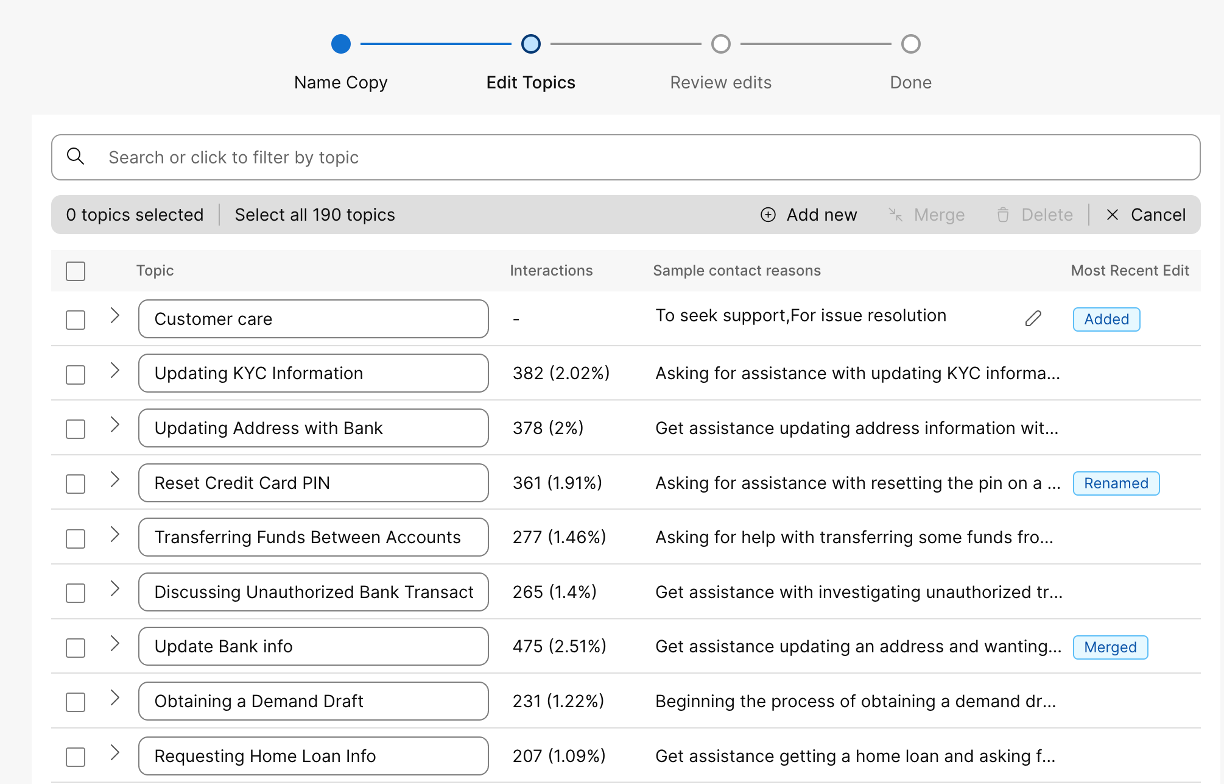
|
| 7 |
Click Next. |
| 8 |
On the Review edits screen, you can review changes made to topics within a collection. The Before column displays the original topics before editing, while the After column displays the edited topics. 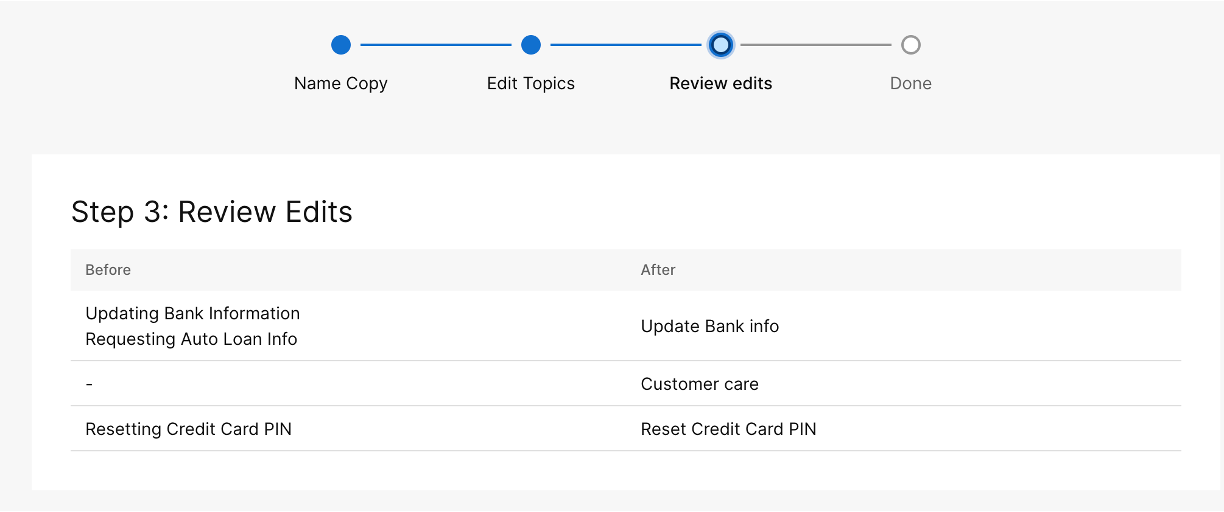
|
| 9 |
Click Create new topic collection. |
| 10 |
On the Done screen, you can view the topic collection details such as Name, Edited from, and Topic changes. Click Done to view the new topic collection on the Topic Analytics page. You can track the progress of the topic collection creation in the Status column. 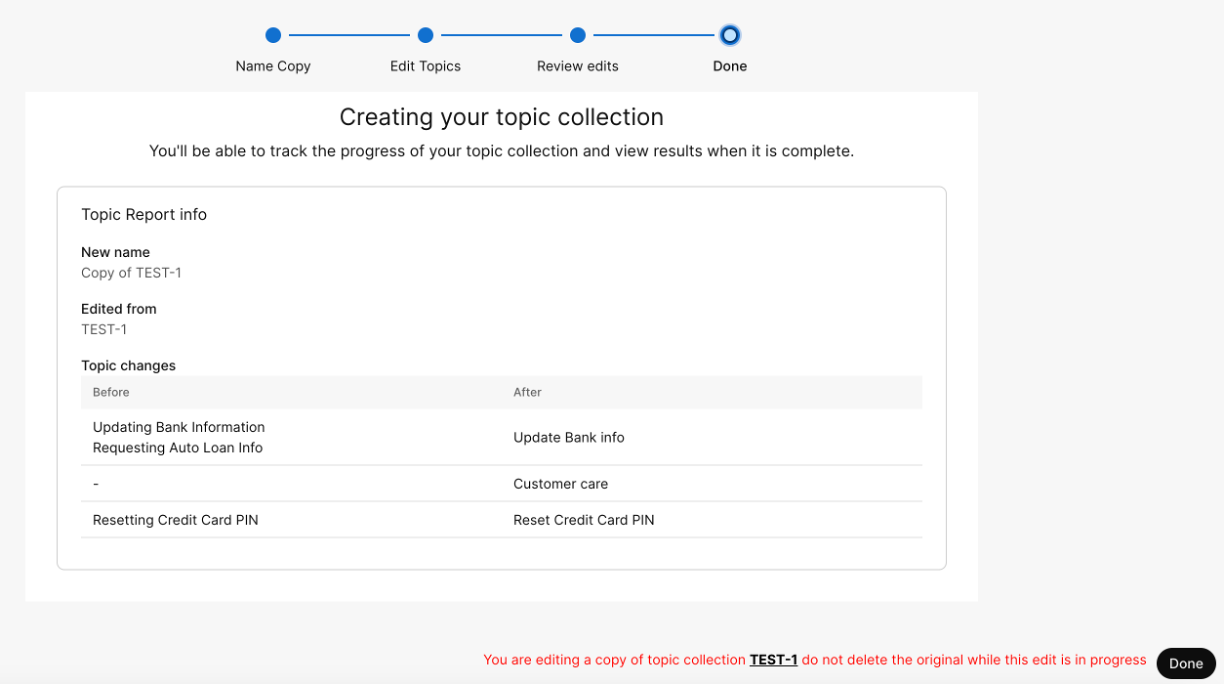
|
Frequently Asked Questions (FAQs)
This section answers frequently asked questions about using the Topic Analytics feature.
- What are the requirements for using the Topic Analytics feature?
Topic Analytics requires a minimum of 2000 meaningful English recordings to function effectively.
- What should I do if I encounter transcription errors or content inaccuracies in Topic
Analytics?
If you experience transcription errors or content inaccuracies, ensure that your call recordings are clear of good quality, and relevant to the topics being analyzed. Transcripts generated from low-quality or irrelevant recordings can lead to inaccuracies, often referred to as hallucinations, where the AI misinterprets the content. Additionally, ensure that you have the required number of meaningful recordings, as a low count of relevant data can also impact the accuracy of the analysis. If these issues still persist, contact technical support for further assistance.
- How do I ensure that Topic Analytics is enabled for my organization?
Topic Analytics is enabled for organizations using the AI Assistant Add-on with version Flex 3.0. Ensure that the user logging in has either the Contact Center Administrator role or the Full Administrator role.
- How does Topic Analytics handle recordings stored with third-party solutions like
Calabrio WFO?
Currently, Topic Analytics is designed to work optimally with recordings stored in Cisco's S3 storage. While recordings managed by third-party solutions like Calabrio WFO may still be accessible for analysis, full functionality and support are ensured when using Cisco's storage. For the latest updates on third-party integration capabilities, consult your account manager.
- Why isn't Topic Analytics offered as a standalone feature?
Topic Analytics is bundled with the AI Assistant to provide a comprehensive suite of features at a consistent cost. This bundling ensures efficient analysis of all interactions. As part of its ongoing development, Topic Analytics will evolve to support more comprehensive, timely, and data-driven decisions. Future enhancements will include new reporting capabilities in Analyzer and expanded channel support, offering increased benefits for agents, supervisors, and AI agent interactions.
- How is billing handled for Topic Analytics, and are conversations billed
multiple times?
Billing is based on the initial processing of each conversation. Conversations are not billed multiple times, even if they are analyzed under different filters. You will not be double billed as part of the bundle; each conversation is charged only once when first processed.
- Why isn't my Topic Analytics data showing in Analyzer?
Topic Analytics data automatically appears in Analyzer reports. If you have existing topic data, you can make it available in Analyzer by triggering an edit or clone job on an older collection. When an interaction is part of multiple collections, only the topic from the most recent collection will be displayed to ensure that you always see the most current topic information for your interactions. For interactions not yet analyzed, the Topic Name and Contact Driver fields will show as 'Null.'

